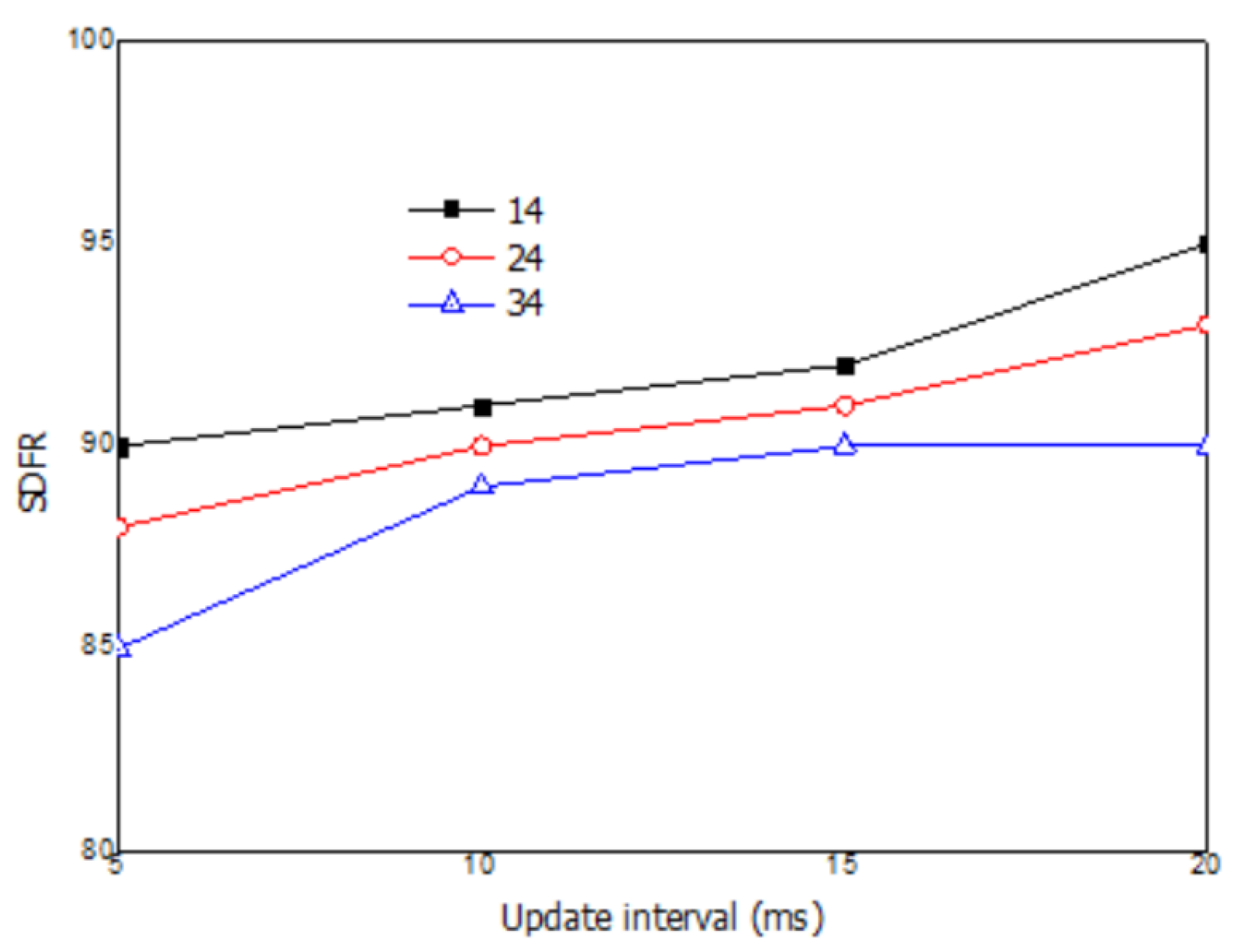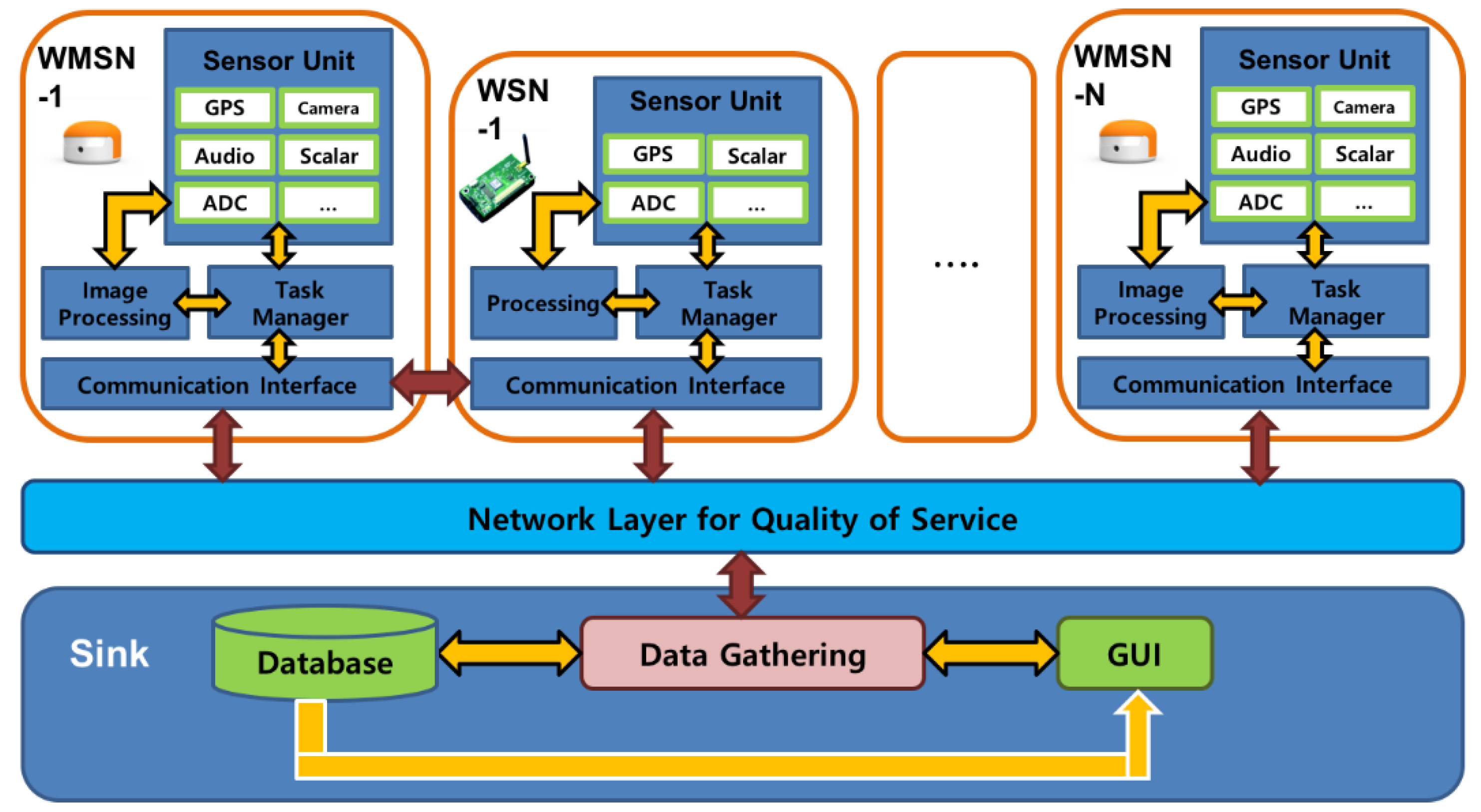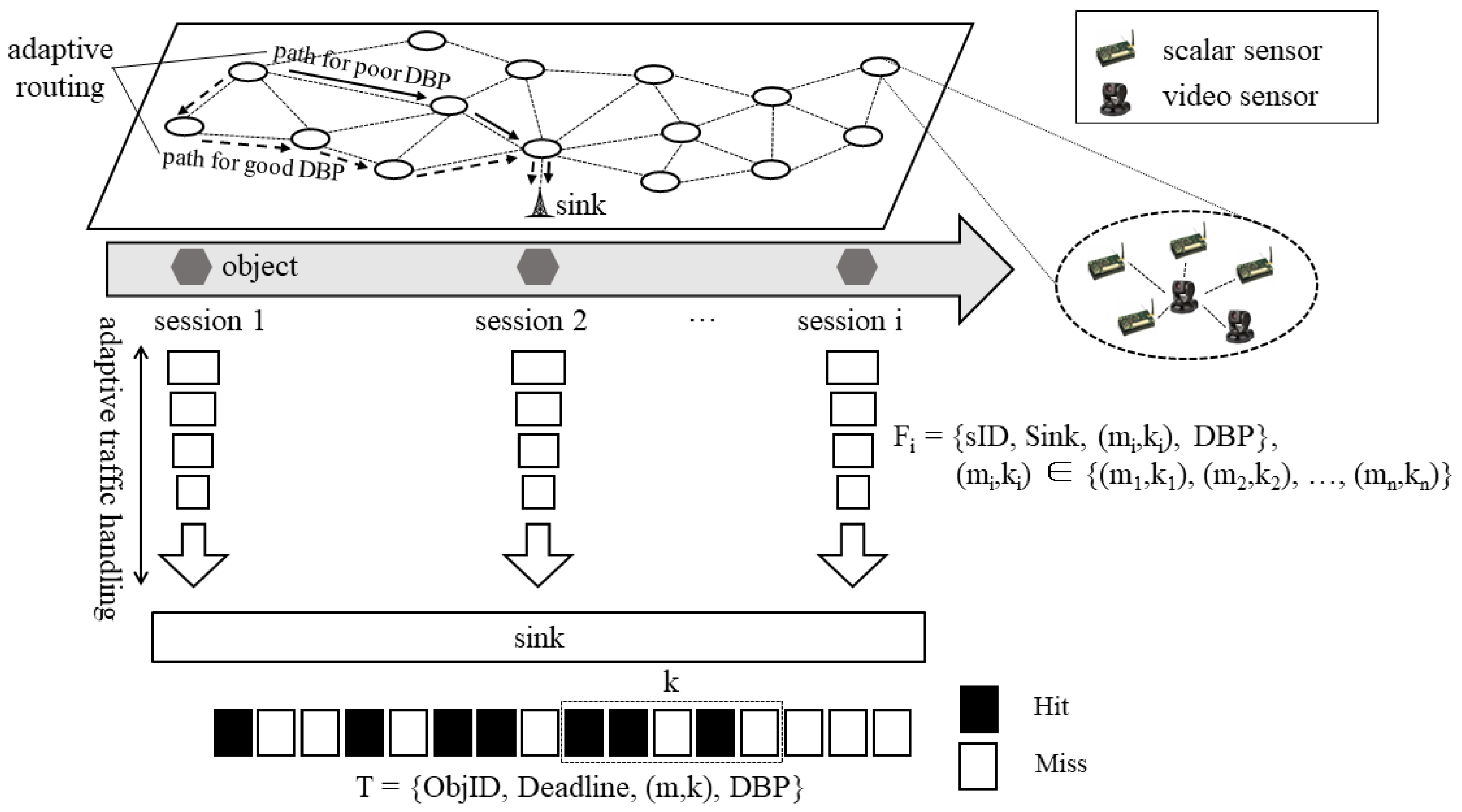1. Introduction
Object tracking technology, which is one among various potential application programs based on wireless sensor network is used in not only surveillance and reducing monitoring cost in defense and medical field but is also expected to be used in reducing power consumption at home and office by turning on/off the lights depending on the movements of a person.
However, the current object tracking technology consisting of location detection [
1] and location update [
2] in the wireless sensor network regardless of the object type transmits only the position information after object detection, application using the collected information are required to be improved because they remain at a level of simply visualizing the transmitted location information. In order to solve this problem, it is possible to apply a technique of transmitting data in the form of a multimedia stream by using a camera and a microphone on a tracked object. But to do this, real-time guarantee of multimedia data is required.
In the aspects of real-time communications, until now the real-time guaranteeing technology in wireless sensor networks has been mainly based on general requirements that do not consider application specificity. For that reason, it is very difficult to define the traffic modeling and requirements to be used in real world. In addition to that, due to various constraints of sensor nodes, there is a limit in developing technologies that guarantee real-time of multimedia. To solve these problems, our research group already have proposed various techniques to apply (m,k)-firm rather than the typical hard/soft real time. (m,k)-firm real-time is defined that a real-time message stream is considered to have an (m,k)-firm guarantee requirement that at least m out any k consecutive messages from the stream must meet their deadlines to ensure adequate Quality of Service (QoS).
But, the proposed techniques [
3,
4] are limited to the technique for real-time guarantee of a single node to a sink node that collects the information, and thus new problems arises when applied directly to object tracking. For this purpose, we aim to provide services by defining multimedia data transmitted from each node as a new (
m,k) -firm model and by consider new (
m,k)-firm model at the sink together. We present network architecture and concept of adaptive QoS routing. In addition, simulation result is given to evaluate the performance of the proposed scheme.
2. Network Architecture and QoS Routing
In the system structure of this study, the general sensor nodes (WSN-1~WSN-N) and wireless multimedia sensor nodes (WMSN1~WMSN-N) with cameras and microphones simultaneously exit that are capable of only processing scalar sensor values. In both nodes there are sensors for detection and a sink node for collecting and processing data as shown in
Figure 1.
After selecting the moving object to be tracked from among many, the task manager of each sensor node implements the algorithm that controls the Field of View of the camera in the distributed environment. The real-time multimedia stream and scalar sensor values are sent to the sink node through the network protocol that guarantee real-time service and communication interface. The corresponding data is stored in the database and using this data, the application program (GUI) execute data analysis and the visualization of moving objects.
2.1. Object Tracking and Adaptive Multimedia Traffic Modeling
Object modelling of multimedia real time streaming, (m,k)-firm, is accomplished by considering the limitation of sensor node and wireless communication. The service quality of the (m,k) -firm model is determined by the Distance-Based Priority (DBP) measured at the sink node. The DBP is a quantitative measure of the degree of satisfaction of the (m,k) condition. The larger the positive direction, the higher the satisfaction of continuous data in real time.
Considering the low bandwidth of the wireless sensor network, it is necessary to apply adaptive modeling that uses different traffic models depending on the network condition. In T = {ObjID, Deadline, (m,k), DBP}, (m,k) is redefined as a set. Being defined as (m,k) = {(m1,k1), (m2,k2), ... (mn,kn)}, it means that, smaller indexes require more stringent quality, and as values continue to be negative, it switch to low-traffic. ObjID is the object ID, Deadline is the end-to-end delay requirement, and (m,k) is the requirements for multimedia playback generated by object tracking.
2.2. QoS Routing
It is composed of a flow
Fi = {
Si, Di, Sink, (mi, ki), DBPi} for an end-to-end session with a sink at a multimedia sensor node (
i) as to develop a QoS routing mechanism with a
DBPi value greater than 0. Applying multi-path routing using speed-based routing metrics to guarantee real-time performance. The primary data transmission route maintains the slowest path as to guarantee real-time performance, and the fastest path is used when the DBP value is negative. The concept of adaptive model and QoS routing are shown in
Figure 2. Adaptive QoS routing chooses the good path with positive DBP value of nodes. For each session, DBP value for each session is passed to the next session. According to this value, a new (
m’,
k’) value is assigned to meet all streams requirements.
3. Performance Evaluation
Performance of the proposed scheme is proved by simulations. We use ns-2 as the simulator. The simulation terrain is set as a 500 m × 500 m field with 50 nodes. A sink is located at the lower right corner of the field so that the end-to-end hop-count ranges from 4 to 9 hops with an average of 6 hops. Each node has a radio range of 40m. Propagation model is set to be Two-Ray Ground where protocols for physical is set to be WirelessPHY. We assume that the location of object is known to all nodes so there is no impact of detection and update algorithm.
Deadline for real-time packet on each node is set to average-link-delay x number of shortest hops, respectively without special mentioning. For the (
m,
k)-firm stream, we introduce three different requirements such as (1,4), (2,4) and (3,4) where they are represented as 14, 24 and 34 in the
Figure 3. Evaluation result is presented as stream dynamic failure ratio (SDFR) where the 95% confidence intervals on the mean are utilized. We vary the update interval for object tracking to observe the impact of traffic for the SDFR.
By referring to
Figure 3, we can find out that SDFD is affected by the update interval. More accurately, lower SDFD is observed when the update interval become short. However, it maintains the acceptable SDFD for (
m,
k)-firm stream by two level adjustment. Among the three traffic model, (3,4) suffers from the lowest SDFD due to strict requirement for real-time. But, due to this requirements, performance is limited to some amount even though adaptive schemes are applied. Also, severe degradation of (
m,
k)-firm stream in previous session can affect the current session significantly, performance enhancement is not great in some cases. However, in the most cases, adaptive routing and DBP control for sessions are feasible to meet (
m,
k)-firm requirements.
4. Conclusions
In this paper, we present object tracking architecture for multimedia WSN. To accommodate the real-time traffic modeled by (m,k)-firm model, adaptive QoS routing algorithm is presented and evaluated through the simulation. Based on results, we can demonstrate that the proposed scheme can achieve the real-time requirement.
Related to this scheme, more consideration for adaptive routing and traffic handling will be studied. Moreover, diverse simulation cases will be performed to study the impacts for the performance.
Figure 3.
Comparison of SDRF for (m,k)-firm traffic.
Figure 3.
Comparison of SDRF for (m,k)-firm traffic.








